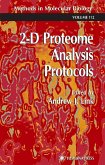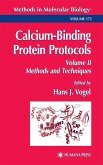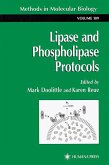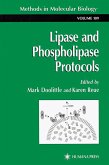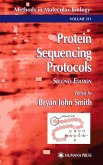With the completion of sequencing projects and the advancement of a- lytical tools for protein identification, proteomics-the study of the expressed part of the genome-has become a major region of the burgeoning field of functional genomics. High-resolution 2-D gels can reveal virtually all p- teins present in a cell or tissue at any given time, including posttranslationally modified proteins. Changes in the expression and structure of most cellular proteins caused by differentiation or external stimuli can be displayed and eventually identified using 2-D protein gels. 2-D Proteome Analysis Protocols covers all aspects of the use of 2-D protein electrophoresis for the analysis of biological problems. The contri- tors include many of the leaders in the fields of biochemistry and analytical chemistry who were instrumental in the development of high-resolution 2-D gels, immobilized pH gradients, computer analysis, and mass spectromet- based protein identification methodologies. Thisbook is intended as a benchtop manual and guide both for novices to 2-D gels and for those aficionados who wish to try the newer techniques. Any group using protein biochemistry-especially in the fields of molecular biology, biochemistry, microbiology, and cell biology-should find this book eminently useful. 2-D Proteome Analysis Protocols takes the researcher through the c- plete process of working with 2-D protein gels from making the protein - tract to finally identifying the proteins of interest. It includes protocols for generating 2-D protein extracts from most of the standard model organisms, including bacteria, yeast, nematode, Drosophila, plants, mouse, and human.
"Our readers will find in this book with its 55 chapters, written by 78 highly well-trained specialists, all they need to come to a good result, going out from the theory of the subject to the precise description of the protocols, the instrumentation, to additive notes, the problems and the eventual difficulties. In one word, an excellent and practical book."-Cellular and Molecular Biology
"...There are 55 chapters covering everything you really need to know to get you to speed in the analysis of the proteome. I really liked the layout of each chapter with a pithy introduction followed by materials and methods sections...an absolute must for the proteomic laboratory."-Microbiology Today
". . .the book covers practical aspects , is well documented, and clearly written . . . recommended for researchers in the field. This collection of protocols is an invaluable starting point for people embarking on attempts to develop new proteomes."-FEBS Letters
"Thewealth of techniques and helpful hints presented in this book should be useful to both neophytes and advanced researchers engaged in the area of high resolution 2-D protein electrophoresis."-Analytical Biochemistry
"...There are 55 chapters covering everything you really need to know to get you to speed in the analysis of the proteome. I really liked the layout of each chapter with a pithy introduction followed by materials and methods sections...an absolute must for the proteomic laboratory."-Microbiology Today
". . .the book covers practical aspects , is well documented, and clearly written . . . recommended for researchers in the field. This collection of protocols is an invaluable starting point for people embarking on attempts to develop new proteomes."-FEBS Letters
"Thewealth of techniques and helpful hints presented in this book should be useful to both neophytes and advanced researchers engaged in the area of high resolution 2-D protein electrophoresis."-Analytical Biochemistry


